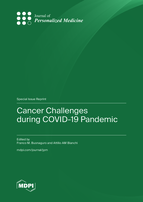Cancer Challenges during COVID-19 Pandemic
A special issue of Journal of Personalized Medicine (ISSN 2075-4426). This special issue belongs to the section "Epidemiology".
Deadline for manuscript submissions: closed (30 June 2022) | Viewed by 37159
Special Issue Editors
Interests: oncology; molecular biology; virology; biochemistry
Special Issues, Collections and Topics in MDPI journals
Special Issue Information
Dear Colleagues,
The COVID-19 pandemic, which presented a greater risk of severe morbidity in older and fragile patients, resulted in higher mortality for people with chronic diseases (particularly cardiovascular disease and diabetes) and cancer, highlighting the weakness of many welfare systems all over the world.
Most responsive cancer institutes have had to redesign their strategies to continue their activities. In particular, new therapeutic protocols and follow-up procedures have been implemented. Patients have had to be carefully evaluated to plan the optimal personalized treatment and to adopt the most appropriate therapeutic strategies, including telemedicine and digital monitoring. Healthcare professionals have had to be monitored for exposure to SARS-CoV-2 using genetic/antigen diagnostic kits and serological tests and, most recently, have been vaccinated with one of the several—not yet fully studied—available vaccines.
Furthermore, general management and planning aspects have also had to be reorganized, with particular attention to the triage of patients for access to day hospital or day surgery sections, outpatient clinics, and clinical wards.
This Special Issue welcomes papers on all clinical topics related to COVID-19 and cancer, including, but not limited to, the following:
- Molecular characterization of SARS-CoV-2 to identify and monitor variants for pathogenicity;
- Immunology, molecular, and systems biology studies for vaccine evaluation in fragile patients;
- Changes in therapeutic strategies for cancer patients to reduce frequency of hospital access;
- Long-term efficacy (i.e., overall survival and disease-free interval) of cancer treatment changes;
- Preclinical and clinical studies to identify effective molecules (innovative molecules or repurposing drugs) for the treatment of COVID-19 in cancer patients;
- Innovative health management that is more effective and more quickly adaptable to unpredictable emerging conditions.
Dr. Franco M. Buonaguro
Dr. Attilio AM Bianchi
Guest Editors
Manuscript Submission Information
Manuscripts should be submitted online at www.mdpi.com by registering and logging in to this website. Once you are registered, click here to go to the submission form. Manuscripts can be submitted until the deadline. All submissions that pass pre-check are peer-reviewed. Accepted papers will be published continuously in the journal (as soon as accepted) and will be listed together on the special issue website. Research articles, review articles as well as short communications are invited. For planned papers, a title and short abstract (about 100 words) can be sent to the Editorial Office for announcement on this website.
Submitted manuscripts should not have been published previously, nor be under consideration for publication elsewhere (except conference proceedings papers). All manuscripts are thoroughly refereed through a single-blind peer-review process. A guide for authors and other relevant information for submission of manuscripts is available on the Instructions for Authors page. Journal of Personalized Medicine is an international peer-reviewed open access monthly journal published by MDPI.
Please visit the Instructions for Authors page before submitting a manuscript. The Article Processing Charge (APC) for publication in this open access journal is 2600 CHF (Swiss Francs). Submitted papers should be well formatted and use good English. Authors may use MDPI's English editing service prior to publication or during author revisions.
Keywords
- COVID-19
- Cancer management and treatment changes
- Telemedicine
- Home monitoring
- COVID-19 prevention and treatment in cancer patients








